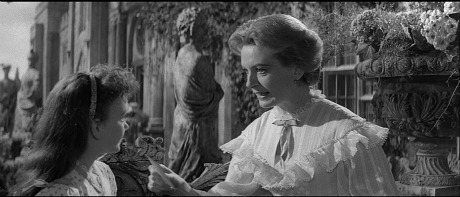In his review of a new British Bluray of Jack Clayton‘s The Innocents, DVD Beaver’s Gary W. Tooze ignores a significant visual element. The 1961 film was clearly shot with older Fox CinemaScope lenses, and therefore suffered from the “CinemaScope mumps,” a syndrome that mostly manifested in CinemaScope films of the ’50s in which actor’s faces (and everything else) looked a tad wider than in actual life.
The “mumps” began to gradually disappear around ’59 or ’60 when then-new widescreen Panavision lenses, which didn’t produce wider-than-normal images, were put into use. But Fox’s British unit was apparently using older-style CinemaScope lenses.
I hate the “mumps” syndrome. It makes me grind my teeth. DVD Talk’s Glenn Erickson noticed it in his 2005 review of an Innocents, to wit: “The only hindrance is that the lenses used appear to be older models that give faces the CinemaScope ‘mumps’ in close-ups. These earlier lenses with distorted fields show up frequently in Fox films made in Europe.”
Millions of moviegoers watched widescreen “mumps” films in the ’50s and early ’60s and didn’t notice or say anything, of course. It’s my cross to bear that I do notice this stuff (like the 1.85 masking of On The Waterfront the other night, which the entire audience was apparently cool with) and being the only guy who goes up to complain, or who writes about it.
Toooze also says, by the way, that “this dual-layered 1080P transfer from the BFI does indeed improve especially in the visibility of grain…[it] is far easier to see, providing some earthy texture to the visuals.” I understand how detail and grain sometimes go hand in hand with older films, but how does a film improve by “the visibility of grain”? Forget it. I don’t want to know.










